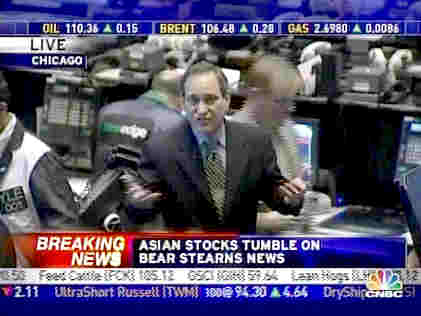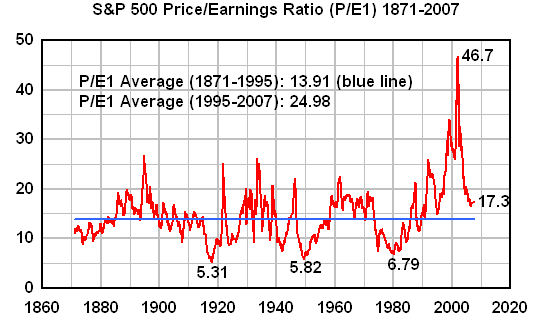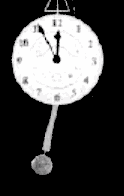
Dynamics

|
Generational Dynamics |
| Forecasting America's Destiny ... and the World's | |
| HOME WEB LOG COUNTRY WIKI COMMENT FORUM DOWNLOADS ABOUT | |
After Bear Stearns collapses in three days, who will be next?
A year ago, in January, 2007, Bear Stearns shares were selling for $171. At the beginning of 2008, they were selling for $85. A week ago it ws $30/share. On Sunday, Bear signed a deal to be acquired by JP Morgan Chase at $2.00 per share.
The Fed and the financial community were putting enormous pressure on both companies to avoid a Bear bankruptcy. The reason is not the obvious one (that investors would lose money). The reason is that many hundreds of small investment firms use Bear as a bank to clear their transactions, and those hundreds of banks would be unable to do business if Bear went bankrupt.
The analog to this is if, hypothetically, a large internet firm like Comcast went bankrupt. It's true that, in such a case, the investors would lose a lot of money, of course. But the worst effect to the public would be that all its customers would instantly lose their internet service.
So it's not that Bear was "too big to be allowed to fail," so much as a need to keep it providing services to its customers.
The problem is that Bear has a huge portfolio of CDOs with high notional values, but completely unknown "mark to market" values, since there IS no market for these CDOs.
Any company acquiring Bear would want to know the values of Bear's assets in order to decide what to bid. Are Bear's assets worth $171 per share? Or are Bear's assets worthless? The answer to that question could not be determined.
And as we wrote last night, there was a panicked desperation for Bear to be acquired before the Asian markets opened on Monday morning, which would be early Sunday evening in New York. The fear was that if Bear remained on the verge of bankruptcy, investors in the Asian markets might panic, and that would spread to Europe and North America on Monday.
What it came down to was that nobody wanted to bid on Bear under these conditions, according to reporting this morning on CNBC.
On Monday morning, the debate centered around two views:
Recall that these CDOs are worth far less than their notional values because they're backed by subprime mortgage loans to homeowners who are simply walking away from their homes. The "glass half empty" view is that these CDOs are near worthless because many people aren't making their mortgage payments. The "glass half full" view is that many people ARE making their mortgage payments, and so these CDOs may be worth more than expected. This is the concept on which the "bull" view of the situation is based.
Unfortunately, the "glass half full" view has a flaw in it. The way that CDOs are set up, it's possible for even AAA rated CDOs to be literally worthless. In the case of "CDOs-squared," it's not only probable, but likely.
(For those interested in the math behind the creation of CDOs, and why even AAA rated CDOs might be literally worthless, see "A primer on financial engineering and structured finance.")
The "bear" point of view was summarized by CNBC pundit Rick Santelli, speaking from the floor of the Chicago Board of Trade:
 |
But I do think that the feeling on this floor is that the adjustment is afoot.
The thing that everybody has dreaded with the reversal of the credit crunch, the pricing of derivatives, the liquidation of collateral -- we are now in it, and we need to pay attention.
The Fed, naturally, according to traders, can't stop the process. They can only be there to insert liquidity. Overnight LIBOR is up big, as one would expect. Fed funds looking for a massive ease tomorrow, and that's chapter two.
Do you keep doing two things. The new things that they're forced to do that will help the liquidation, and do you keep liquifying, which is killing the dollar, and doing them no imminent good. That's the debate for the next 24 hours."
(Just a word of explanation: When Santelli says "Fed funds looking for a massive ease tomorrow," he's referring to the value of options on the Fed funds futures. Santelli is saying that investors are expecting the Fed to perform a "massive ease" in the Fed funds rate on Tuesday, when the Fed has a regularly scheduled meeting.)
For those readers who are trying to decide whether the "bull" view or the "bear" view will prevail, I would make the following point: The "bull" point of view has been wrong every time since August, and almost every time since the housing bubble started leaking two years ago. We've heard, "there's no housing bubble," then "housing prices have bottomed," then "housing prices have bottomed" again (and again), then the "subprime crisis is contained to suprime mortgages," then "the subprime crisis is contained to mortgages," then "the subprime crisis will be over after this quarter" (multiple quarters).
Every time, there's always a form of spin that says that the bad news is temporary, or that the bad news is really good news.
I'm always struck by how these investors always seem to believe that "history always begins this morning." They look at one data value or one part of the financial system, and have no concept of how the different parts of the world financial system are interlinked into one huge heavily interconnected system. They also have no idea how events propogate through that system, and how things that happened years or decades ago are still propogating through the system today.
As I've been saying hundreds of times since 2002, the stock market is overpriced by a factor of close to 250%, as I described in "How to compute the 'real value' of the stock market," indicating that we're entering a new 1930s style Great Depression. In 2002 I had no idea what scenario we would follow to reach that point, but the end result has always been certain with 100% probability.
Here's the first graph that I used in that article:
 |
Have you ever seen anything like this graph in any financial publication? P/E ratios, or "valuations," are standard tools used by investors. But no one will publish it because it's about as close to a mathematical proof as you could hope for that we're headed for a major stock market crash. This graph shows that P/E ratios regularly fall to the 5-10 range, and that we're on the edge for another such collapse.
Now here's the thing: Over the years, I've gotten many personal remarks and e-mail messages about my "Great Depression" prediction, and I've been called all sorts of names.
But not one single person has ever challenged that graph (or its similar predecessors). No one says to me, "You haven't accurately graphed the P/E ratio index - you've drawn the graph wrong." No one says to me, "You've drawn the graph right, but here's why you're interpreting it incorrectly."
Instead, what I see all the time in financial publications, and hear all the time in CNBC is totally incorrect interpretations of the P/E ratio, calling stock valuations "cheap" at the current inflated value. Many of these people apparently don't even know how to compute a P/E value. (Hint: It's price per share divided by last year's earnings per share. Duh!) Why investment managers with six and seven figure salaries can't understand P/E ratios is beyond me.
I'm certainly not the only person who's understood this. In his March 2003 newsletter to his Berkshire Hathaway investors, Warren Buffett said that stocks were still significantly overpriced at that time -- and at that time, the Dow Industrials were at 8000!
And one day in 2005, I was watching Neil Cavuto's money show on FNC, where famous "bear" David W. Tice was appearing as a guest. He was asked where the market was going and he said, "Oh, it's going to fall below 4000." Cavuto shut him off instantly. Pundits like Cavuto don't even want to HEAR something like that.
To repeat what I've said before, if you go back through history, there are many small or regional recessions. But since the 1600s there have been only five major international financial crises: the 1637 Tulipomania bubble, the South Sea bubble of the 1710s-20s, the bankruptcy of the French monarchy in the 1789, the Panic of 1857, and the 1929 Wall Street crash.
These are called "generational crashes" because they occur every 70-80 years, just as the generation of people who lived through the last one have all disappeared, and the younger generations have resumed the same dangerous credit securitization practices that led to the previous generational crash. After each of these generational crashes, the survivors impose new rules or laws to make sure that it never happens again. As soon as those survivors are dead, the new generations ignore the rules, thinking that they're just for "old people," and a new generational crash occurs.
We're now overdue for the next generational crash, and it might occur tomorrow, next week, next month, or next year.
The collapse of Bear Stearns is VERY ominous, because it portends a chain reaction that will cause forced selling among many other firms.
 |
Here's a final note from The Twilight Zone:
Some pundits on CNBC are hoping for a 500 point collapse in the Dow Industrials. Why? Because that would be a stock market capitulation signal, meaning that the market had bottomed, and would start going up again (meaning that the credit and housing bubbles would have to start reflating, which is impossible).
My response to this is as follows: Be careful what you wish for.
(17-Mar-08)
Permanent Link
Receive daily World View columns by e-mail
Donate to Generational Dynamics via PayPal
Web Log Summary - 2016
Web Log Summary - 2015
Web Log Summary - 2014
Web Log Summary - 2013
Web Log Summary - 2012
Web Log Summary - 2011
Web Log Summary - 2010
Web Log Summary - 2009
Web Log Summary - 2008
Web Log Summary - 2007
Web Log Summary - 2006
Web Log Summary - 2005
Web Log Summary - 2004
Web Log - December, 2016
Web Log - November, 2016
Web Log - October, 2016
Web Log - September, 2016
Web Log - August, 2016
Web Log - July, 2016
Web Log - June, 2016
Web Log - May, 2016
Web Log - April, 2016
Web Log - March, 2016
Web Log - February, 2016
Web Log - January, 2016
Web Log - December, 2015
Web Log - November, 2015
Web Log - October, 2015
Web Log - September, 2015
Web Log - August, 2015
Web Log - July, 2015
Web Log - June, 2015
Web Log - May, 2015
Web Log - April, 2015
Web Log - March, 2015
Web Log - February, 2015
Web Log - January, 2015
Web Log - December, 2014
Web Log - November, 2014
Web Log - October, 2014
Web Log - September, 2014
Web Log - August, 2014
Web Log - July, 2014
Web Log - June, 2014
Web Log - May, 2014
Web Log - April, 2014
Web Log - March, 2014
Web Log - February, 2014
Web Log - January, 2014
Web Log - December, 2013
Web Log - November, 2013
Web Log - October, 2013
Web Log - September, 2013
Web Log - August, 2013
Web Log - July, 2013
Web Log - June, 2013
Web Log - May, 2013
Web Log - April, 2013
Web Log - March, 2013
Web Log - February, 2013
Web Log - January, 2013
Web Log - December, 2012
Web Log - November, 2012
Web Log - October, 2012
Web Log - September, 2012
Web Log - August, 2012
Web Log - July, 2012
Web Log - June, 2012
Web Log - May, 2012
Web Log - April, 2012
Web Log - March, 2012
Web Log - February, 2012
Web Log - January, 2012
Web Log - December, 2011
Web Log - November, 2011
Web Log - October, 2011
Web Log - September, 2011
Web Log - August, 2011
Web Log - July, 2011
Web Log - June, 2011
Web Log - May, 2011
Web Log - April, 2011
Web Log - March, 2011
Web Log - February, 2011
Web Log - January, 2011
Web Log - December, 2010
Web Log - November, 2010
Web Log - October, 2010
Web Log - September, 2010
Web Log - August, 2010
Web Log - July, 2010
Web Log - June, 2010
Web Log - May, 2010
Web Log - April, 2010
Web Log - March, 2010
Web Log - February, 2010
Web Log - January, 2010
Web Log - December, 2009
Web Log - November, 2009
Web Log - October, 2009
Web Log - September, 2009
Web Log - August, 2009
Web Log - July, 2009
Web Log - June, 2009
Web Log - May, 2009
Web Log - April, 2009
Web Log - March, 2009
Web Log - February, 2009
Web Log - January, 2009
Web Log - December, 2008
Web Log - November, 2008
Web Log - October, 2008
Web Log - September, 2008
Web Log - August, 2008
Web Log - July, 2008
Web Log - June, 2008
Web Log - May, 2008
Web Log - April, 2008
Web Log - March, 2008
Web Log - February, 2008
Web Log - January, 2008
Web Log - December, 2007
Web Log - November, 2007
Web Log - October, 2007
Web Log - September, 2007
Web Log - August, 2007
Web Log - July, 2007
Web Log - June, 2007
Web Log - May, 2007
Web Log - April, 2007
Web Log - March, 2007
Web Log - February, 2007
Web Log - January, 2007
Web Log - December, 2006
Web Log - November, 2006
Web Log - October, 2006
Web Log - September, 2006
Web Log - August, 2006
Web Log - July, 2006
Web Log - June, 2006
Web Log - May, 2006
Web Log - April, 2006
Web Log - March, 2006
Web Log - February, 2006
Web Log - January, 2006
Web Log - December, 2005
Web Log - November, 2005
Web Log - October, 2005
Web Log - September, 2005
Web Log - August, 2005
Web Log - July, 2005
Web Log - June, 2005
Web Log - May, 2005
Web Log - April, 2005
Web Log - March, 2005
Web Log - February, 2005
Web Log - January, 2005
Web Log - December, 2004
Web Log - November, 2004
Web Log - October, 2004
Web Log - September, 2004
Web Log - August, 2004
Web Log - July, 2004
Web Log - June, 2004